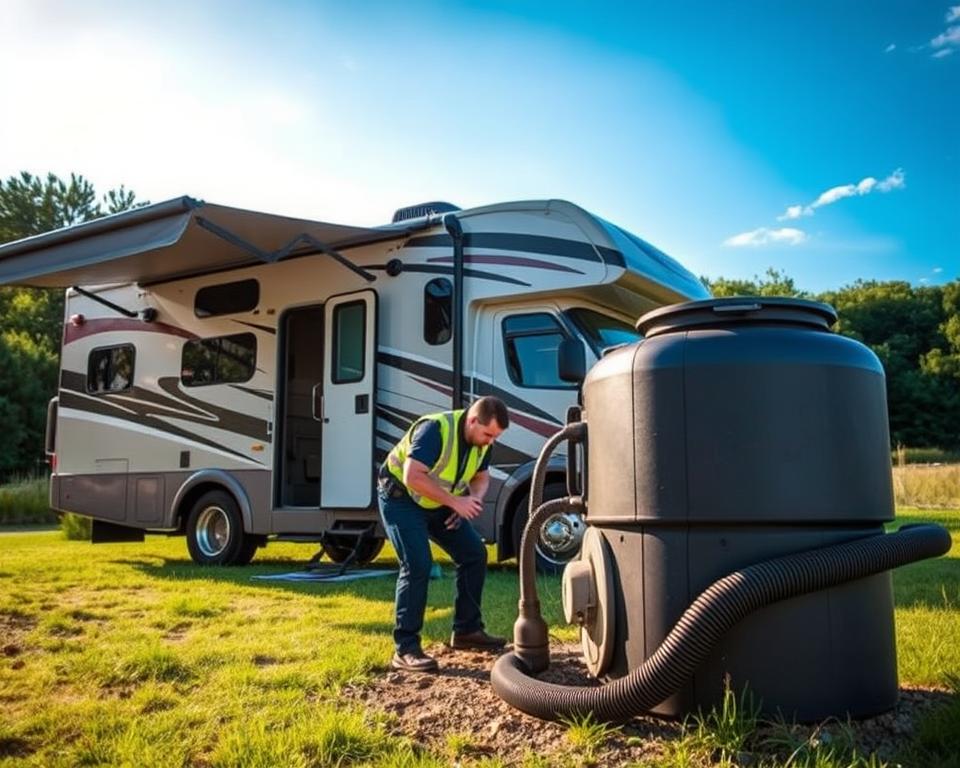Onsite Effluent System: Your Manual to Selection & Maintenance
Were you aware almost one in five U.S. homes uses a septic setup for sewage treatment? This fact demonstrates how vital it is to understand about septic wastewater pumps. If you are unfamiliar with septic systems or thinking of average cost of septic pumping near me, understanding septic pumps is crucial. It helps with handling waste at your residence.
This manual will give you the basics on septic setup pumps. It aids in keeping your sewage pump running well and prevents expensive fixes. By gaining knowledge about septic setups and the septic effluent pump’s role, you can make smart choices. These decisions will improve your wastewater treatment’s effectiveness and lifespan.
Understanding the Basics of Septic Setups
Septic setups are key for homes not hooked up to city sewage systems. They treat and get rid of domestic wastewater. Understanding how they function is crucial for maintaining them operating efficiently.
What Is a Septic Setup?
A septic system is an underground arrangement for wastewater treatment. It’s used a lot in rural and suburban places. It breaks down solids and fluids, letting waste to decompose organically with bacteria. The cleaned water then is absorbed by the soil, finishing the treatment.
Parts of a Septic System
The key parts of a septic setup are:
- Pipes from the residence
- Septic tank
- Leach field
- Soil
These components work together to process wastewater efficiently. The septic reservoir is where most treatment happens. The drainfield distributes the cleaned water into the earth.
How Wastewater is Processed
First, sewage enters the septic reservoir. There, it separates. Solids sink to the base, and fats floats up. This lets some breaking down to occur with natural helpers.
Then, the fluid portion goes to the drainfield. There, the soil filters it further by filtering out contaminants. This makes the water suitable to go back into the ground.
| Part | Description | Function |
|---|---|---|
| Pipes from the home | Connect household plumbing to the septic reservoir | Convey wastewater to the reservoir |
| Septic tank | An subterranean chamber for primary sewage treatment | Separates solids and liquids for breakdown |
| Leach field | A system of channels filled with stones | Disperses treated wastewater into the earth |
| Soil | Naturally occurring earth materials | Purifies contaminants from wastewater before entering groundwater |
Significance of the Septic Wastewater Pump
The septic effluent pump is key to a septic system’s success. It makes sure treated sewage is expelled smoothly. Homeowners who rely on these setups benefit a lot from knowing how it functions.
What Exactly is a Septic Wastewater Pump?
A septic effluent pump is made to push processed fluid from the septic tank to the leach field. It’s crucial when the drainfield is up high. Without it, the setup might not function properly, leading to big repair expenses.
Its Role in Wastewater Treatment
The pump’s task starts after waste materials decompose in the reservoir. Then, it sends the liquid to the drainfield. There, it is purified by earth-based bacteria. This maintains the septic system and the surroundings healthy.
Selecting the Appropriate Septic Effluent Pump for Your Needs
Choosing the right septic wastewater pump is key to a efficient sewage setup. There are many options, each tailored for different needs. Understanding the types of pumps and what to consider aids make a good choice.
Types of Septic Pumps
Here are some primary types of septic pumps:
- Submersible Pumps: These pumps work underwater and are ideal for deep setups.
- Sewage Pumps: Designed for moving wastewater, they manage big waste materials and are vital for the setup to work right.
- Wastewater Pumps: These pumps are for transferring processed sewage from the tank to the drain field, maintaining continuous flow.
Factors to Consider When Choosing a Pump
When picking a septic pump, think about these factors:
- Horsepower: Select a pump with the appropriate power output for the volume of sewage you manage.
- Flow Rate: Figure out the required flow rate you need for the pump to operate efficiently.
- Depth of Installation: The pump’s installation depth is important, affecting the type you require.
Suggested Brands and Models
Some brands are known for their quality and reliability. Here are a few:
- Zoeller Pumps: Provides trustworthy wastewater and underwater pumps.
- Liberty Pumps: Has a variety of wastewater and waste pumps for long-lasting performance.
- Wayne: Known for dependable underwater pumps and robust performance for residences.
Talking to experts can assist you pick the best septic pump for your requirements.
Septic Effluent Pump: Your Maintenance Guide
Maintaining your septic wastewater pump in good shape is key to a working septic setup. If you ignore it, you might encounter issues and costly fixes. Routine maintenance prolongs the pump’s lifespan and keeps your septic setup in good working order.
Routine Care Necessities
For your septic reservoir pump to function properly, you need do routine checks. Examine the pump once every three years. Make sure to:
- Check the pump operation and efficiency.
- Ensure all electrical connections are secure.
- Remove any debris or clogs from the pump area.
- Inspect the float switch for correct functioning.
Regular care stops the pump from malfunctioning prematurely. Getting help from a pro like experienced service providers can enhance your maintenance efforts.
Indicators of Necessary Pump Care
Be alert to certain signs to know when your septic wastewater pump requires attention. Be mindful of:
- Unusual sounds from the pump.
- Overflows in your pipes.
- Slow draining in sinks and toilets.
- Foul odors near the septic reservoir.
Addressing these problems promptly avoids greater expenses. Knowing these indications allows you to respond quickly, protecting your septic system.
| Maintenance Task | Frequency | Purpose |
|---|---|---|
| Inspect pump operation | Once every three years | To ensure peak performance |
| Check wiring | Every inspection | Avoid wiring issues |
| Clear blockages | Whenever necessary | Ensure uninterrupted flow |
| Check float switch | At each inspection | Verify correct activation of pump |
Typical Problems with Septic Pumps
Septic pumps are vital for a working septic system. They can face multiple problems that impact their work. Being aware of the signs of septic pump failures is key for residents. Be vigilant for unusual sounds, frequent backups, or flooding in the leach field. Identifying these signs early can avoid bigger problems later.
Identifying Pump Failures
Septic pumps frequently malfunction due to physical or power-related issues. Monitoring your septic system can help you notice problems at an early stage. Watch for changes in how frequently the pump cycles or strange odors near the tank. These indications mean there might be a problem. Identifying these issues early can avoid bigger troubles.
Precautionary Steps to Avoid Issues
Regular maintenance ensures your septic pump working well. Examining the system often, practicing water conservation, and getting rid of waste correctly contributes a lot. Avoid disposing of things like grease, chemicals, or indestructible waste in the system. Adhering to these steps aids in keeping your pump running smoothly and lowers the likelihood of major failures.



